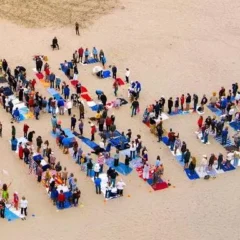This post is adapted from a longer white paper on 20 years of Charitable Choice.
Twenty years ago, President Bill Clinton enacted the Personal Responsibility and Work Opportunity Reconciliation Act of 1996 known as welfare reform. This bill not only radically changed “the rules poor people live by,” as sociologist Mark Chavez put it, it also fundamentally changed the institutional environment for the delivery of social services in the United States by allowing religious organizations to be eligible for public funding.
Section 104 of the legislation contains a provision known as “Charitable Choice.” This provision requires states to include religious organizations as eligible contractees, if they contract with nonprofit organizations for delivery of social services.
Before the Charitable Choice provision, explicitly religious organizations were not eligible for public funding for the delivery of social services due to the constitutional principle of separation of church and state. Religious groups’ access to government funding with Charitable Choice was a significant change that has had a major influence on social service delivery in the U.S. over the last 20 years. Yet it has not been without controversy. And often, these controversies have come at the expense of empirical outcome-based research on the measurable impact (or lack thereof), typology and institutional nuance of religious actors receiving public funds.
Despite legal precepts on the separation of church and state, public institutions and political figures have continually turned to faith communities to address social issue. Even before Charitable Choice, many faith groups played a powerful social role by filling voids in under-served areas, whether in directly providing food, clothing and shelter to people in need or creating change in their community through organizing and policy. Indeed, F.E. Johnson called churches “the mother of social work” in 1941.
While many did such work with private funding prior to 1996, organizations affiliated with religious denominations (Jewish Federations, Catholic Charities, Lutheran Social Services etc.) could receive government money, if they were run as separate non-profit organizations that provided needed services without infusing a religious component. Charitable Choice allowed pervasively sectarian institutions (churches, synagogues, mosques) to receive government funding as well.
The law remained vague in several areas, prompting waves of debate on contentious issues.
Early proponents of Charitable Choice argued that religion itself allows faith-based organizations to help individuals and address social problems. Faith-based organizations offer a more holistic approach to meeting individuals’ needs, they argued.
Early opponents of Charitable Choice were equally vocal about their concerns, from the potential for proselytization on the government’s dime to the threat that government funding would prevent religious actors from speaking prophetically.
In fact, even today, questions over faith-based organizations’ ability to discriminate in hiring continue to be part of the mainstream debate. A media analysis by the Pew Research Center indicates that since 2001 a change of policy issues from general questions of constitutionality to more concrete debates about faith-based hiring have become popular news items. At the same time, another Pew survey suggests that religious service provision has remained quite popular: during the last decade there has always been a two-third majority of Americans in favor of the faith-based initiative and some 37 percent of all respondents have stated that “religious organizations can best help the needy.”
While some seem to see Charitable Choice as government’s attempt to absolve itself of solving social problems and dumping them on the steps of the church. Others believe it is an acknowledgement of the role and power of religious actors in society.
Either way, arguments for and against Charitable Choice have done very little to empirically advance what is known about how religious actors behaved when competing for public funds.
Click here for a bibliography of scholarship on Charitable Choice
In the decades since welfare reform was signed into law, scholarly work has acknowledged that Charitable Choice succeeded in bringing religious organizations into the fold of government, and that they are exemplary at meeting discrete community needs and in collaborating to solve complex social problems. Still, researchers found that religious actors lack capacity, training and nuanced understanding necessary to be effective in many areas. Yet, many questions remain about Charitable Choice and its legacy.
Are faith-based organizations more or less effective than secular organizations? Does ‘faith’ empower organizations to more effective action? What should “partnerships” between government and faith communities look like? The more important question remains, does research exist to answer these questions?
At 20 years after the start of direct public funding to faith-based organizations, we know that we need more outcome-based measurements. A results orientation is crucial in helping faith-based organizations, policy makers and researchers understand how faith communities operate and their impact, or lack thereof.
CRCC is hosting a series of conversations on the legacy and future of Charitable Choice with Loyola Marymount University and the Knight Program for Media and Religion September 28-30, 2016. Please join us for a special keynote from Melissa Rogers, special assistant to the President and executive director of the White House Office of Faith-based and Neighborhood Partnerships on Thursday, September 29 at 7 p.m. Click here for details and to RSVP.
Hebah Farrag was the assistant director of research of the USC Center for Religion and Civic Culture through 2023.






